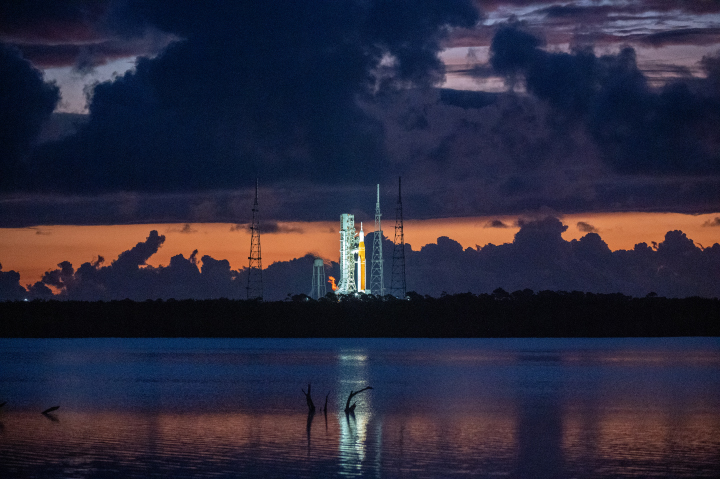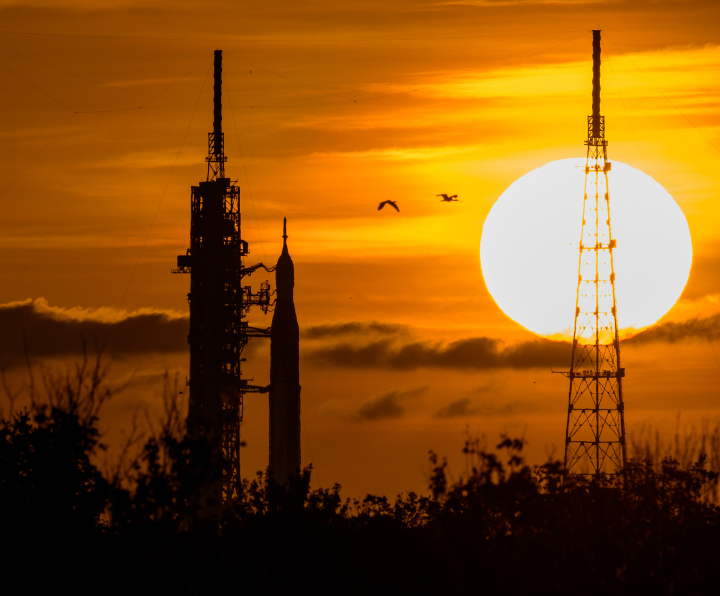

Astronauts often look back at Earth and snap photographs, creating a deep archive of images that are both beautiful and useful for science. But just as many scientists and engineers at NASA have their eyes set on the Moon again, so too do the astronauts.
A crew member onboard the International Space Station (ISS) took this photograph in May 2022 while orbiting more than 400 kilometers (250 miles) above Earth’s surface. At the time, the ISS was located over the South Pacific Ocean about 500 kilometers (300 miles) southwest of Tahiti.
Only a small amount of ocean is visible in this photo. Instead, the sideways-looking view features Earth’s limb—and layer upon layer of atmosphere. Clouds hover in the troposphere, the layer closest to the planet’s surface. Higher up in the stratosphere and mesosphere, the sky darkens as there are fewer particles around to scatter light. In the distance, the waning-gibbous Moon shines like a beacon through Earth’s thinnest layers of atmosphere.
This rocky companion of Earth is the focus of NASA’s Artemis missions, which will return astronauts to the Moon while testing tools and ideas for human missions to Mars. A key purpose of the uncrewed Artemis I mission is to assure that the crew module can safely make its entry and descent through Earth’s atmosphere, as well as its splashdown and recovery. The following mission, Artemis II, will include a human crew.


This pair of photos shows NASA’s Space Launch System (SLS) rocket, with the Orion spacecraft aboard, during preparations for the launch of Artemis I. NASA photographer Keegan Barber shot the first photograph on August 29, 2022. The launch attempt that day was canceled when engines on the rocket’s core stage were unable to meet the proper temperature range. NASA photographer Bill Ingalls shot the second photograph at sunrise while launch preparations continued on August 31, 2022. The next launch attempt was targeted for September 3.
In both photos, the launch site is framed by distinct features of our atmosphere. For example, looming clouds speak to the ample warmth and humid air in Florida in summertime, when storms are almost a daily occurrence. (As of August 31, sporadic rain showers were predicted around the September 3 afternoon launch window.) In the sunrise photo, the low horizon appears red because more blue light gets scattered when sunlight has to travel to our eyes through more of the gases and particles in the atmosphere.
In contrast, the Moon does not have an atmosphere, at least not in the sense that Earth does. Instead, the Moon has a very thin, tenuous layer of unbreathable gases known as an exosphere.
For the past five decades, astronauts have lived and worked in orbit around Earth, snapping millions of photos of their home planet. In due time, they will observe home again from across 240,000 miles of space.
Astronaut photograph ISS067-E-70919 was acquired on May 21, 2022, with a Nikon D5 digital camera using an 420 millimeter lens and is provided by the ISS Crew Earth Observations Facility and the Earth Science and Remote Sensing Unit, Johnson Space Center. Additional images taken by astronauts and cosmonauts can be viewed at the NASA/JSC Gateway to Astronaut Photography of Earth. Photographs by NASA/Keegan Barber and NASA/Bill Ingalls. Story by Kathryn Hansen.